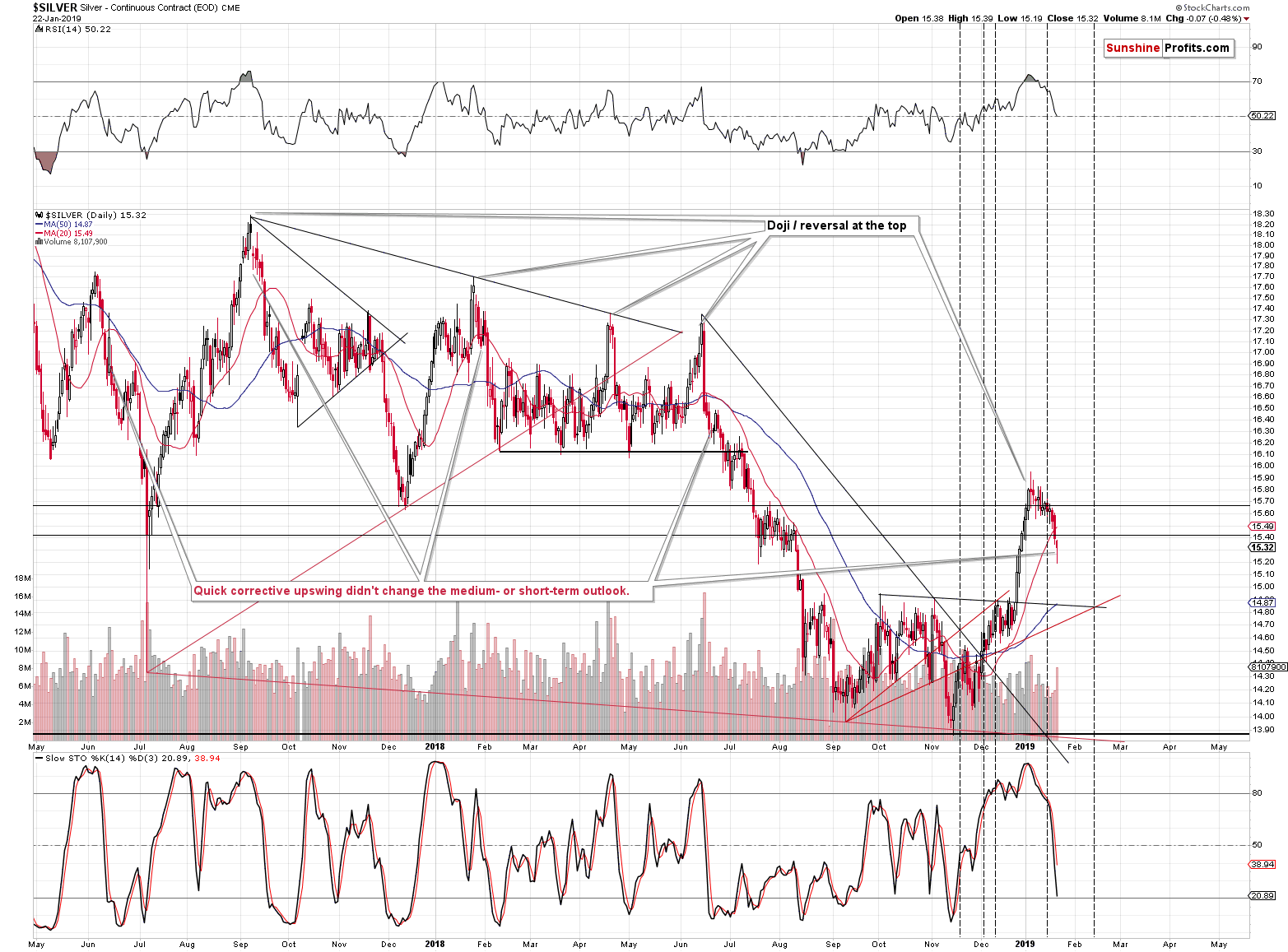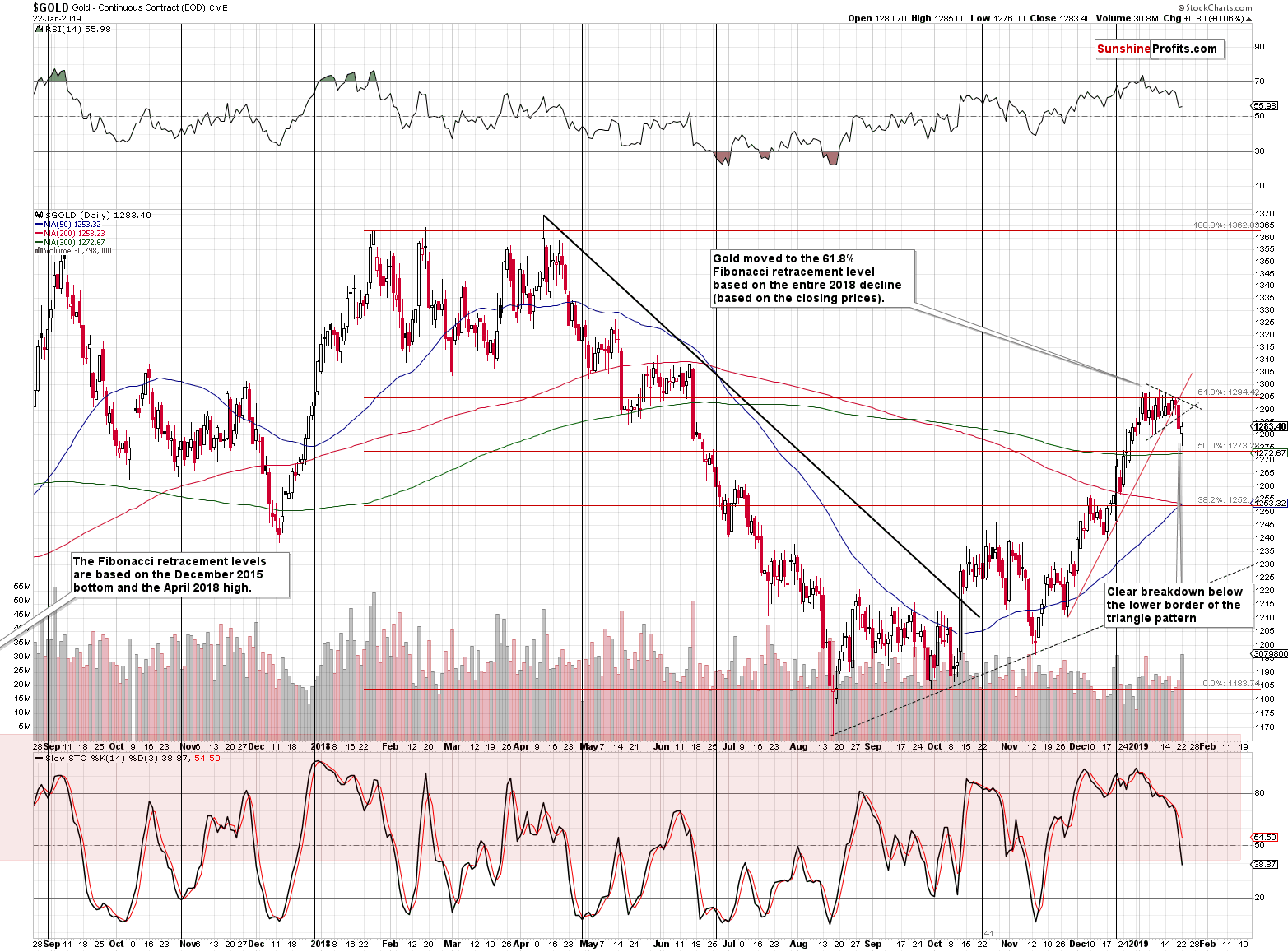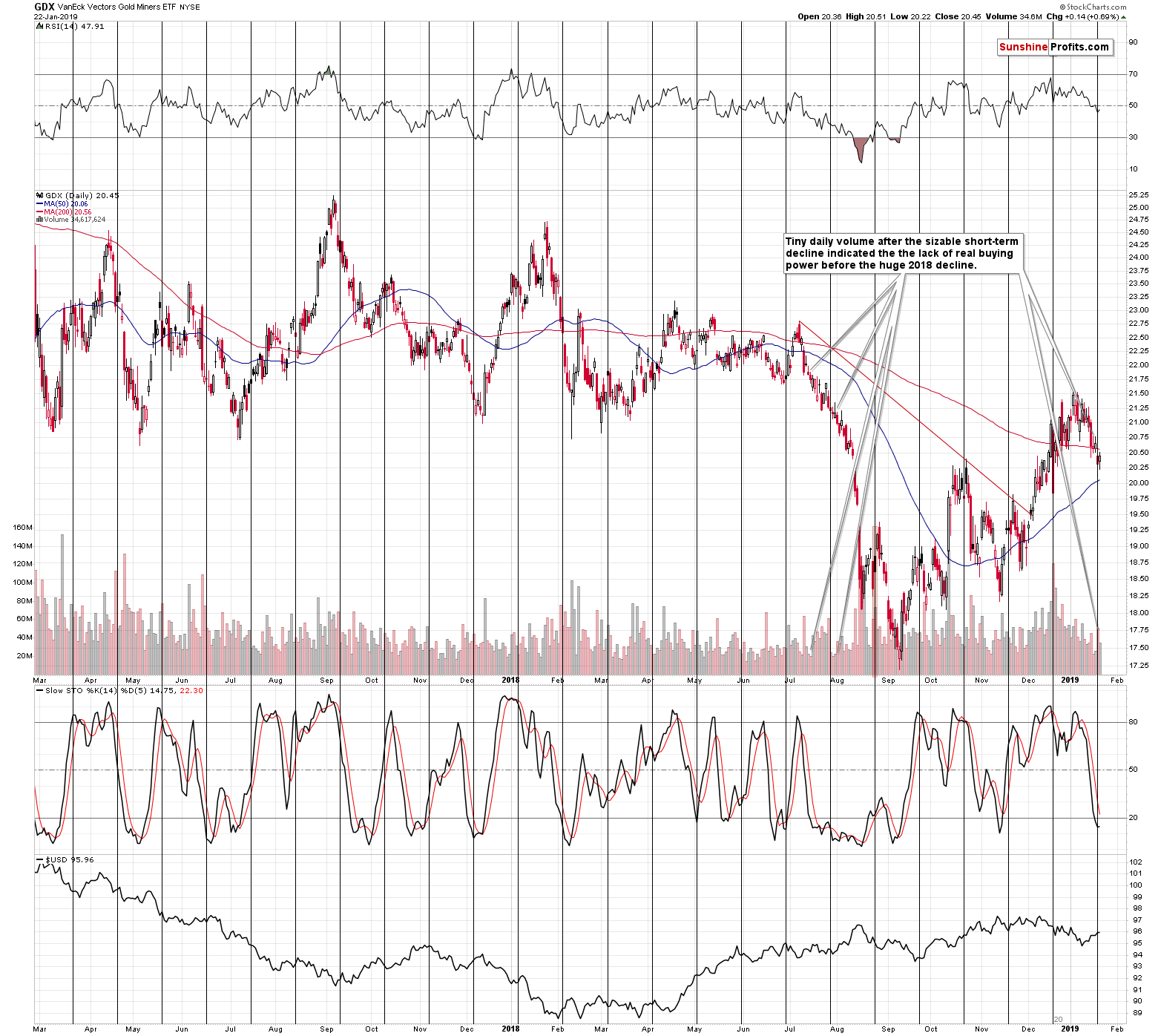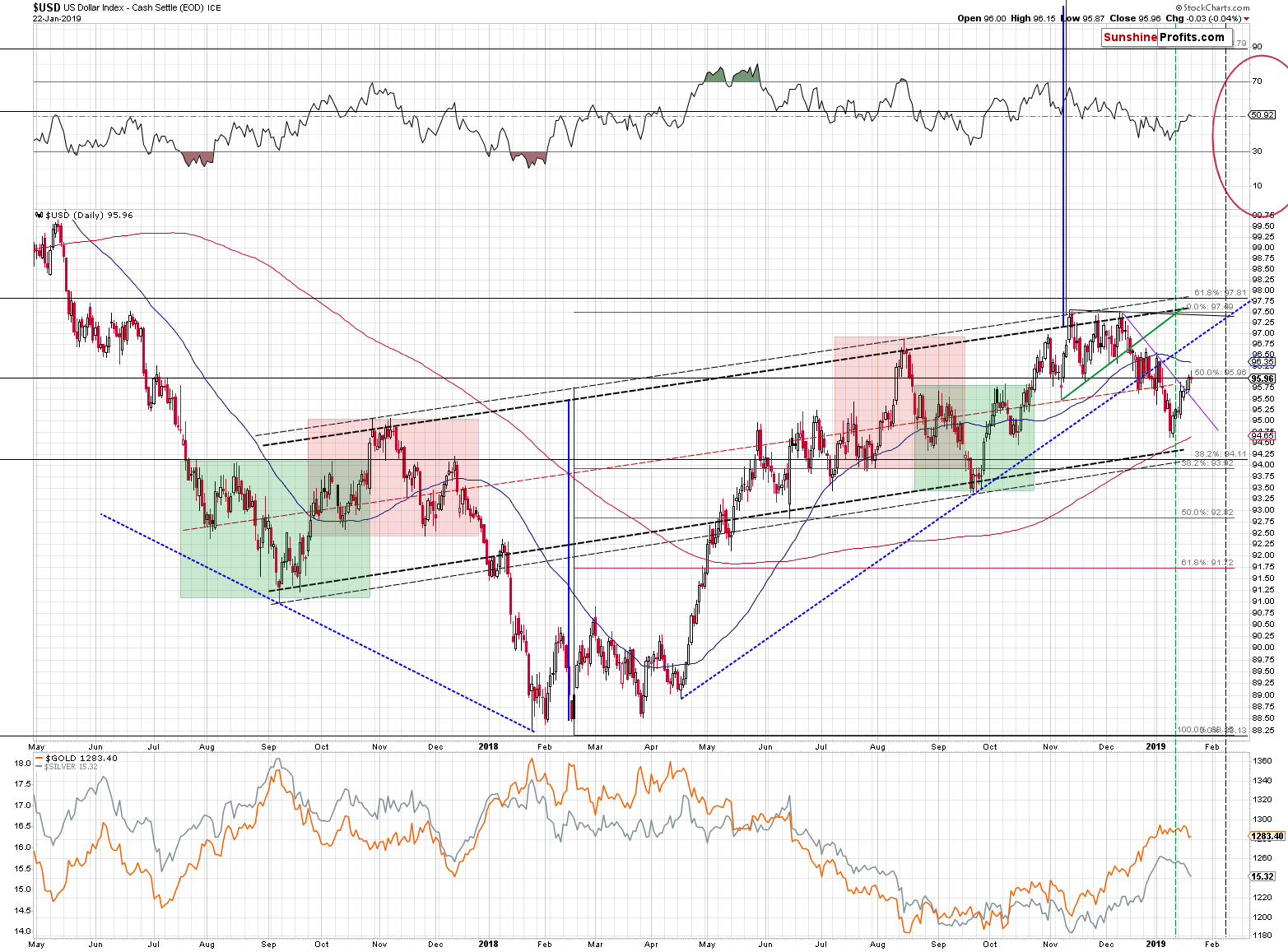Briefly: in our opinion, full (250% of the regular size of the position) speculative short positions in gold, silver and mining stocks are justified from the risk/reward perspective at the moment of publishing this Alert.
Gold closed yesterday’s session higher and silver closed it lower, which is normal given the situation in the gold to silver ratio. Both reversed on an intraday basis, which is still nothing uncommon as corrections right after breakdowns are quite common. What is not normal, however, is for such a daily reversal to be confirmed by big volume. And that’s exactly what we saw yesterday. Are we going to see another powerful wave higher before the decline resumes?
It may be the case that we see a quick upswing here but is not the most likely outcome in our view. And even if, the wave higher is not likely to be anything significant.There are multiple long-term reasons for it and three short-term ones. Before presenting the latter, let’s see what exactly happened.
Gold’s and Silver’s Bullish Reversals
Gold closed for another day below the lower border of the previously broken triangle pattern, which has bearish implications. However, on a stand-alone basis, the session was bullish because it was a big-volume reversal. There were practically no similar cases in the recent past (no big-volume reversals close to a top), so we’ll have to rely on the general interpretation. And the general interpretation is that we should be expecting higher prices on the next day or a few of them.
Actually, this doesn’t necessarily invalidate anything that we recently wrote. Gold could move back to the lower border of the triangle pattern and verify it as resistance, thus making the breakdown complete and confirmed. Moreover, let’s not forget that there are powerful reversals just around the corner – at the end of January or in early February.The vertex of the above-mentioned triangle pattern is also nearby – on Friday or Monday. Consequently, even if we do see a rally, it would likely be short-lived, likely not longer than 2-3 trading days. The upside is also very limited as gold is still relatively close to its recent highs. We don’t expect them to be exceeded even if gold rallies.
Naturally, we may see a bearish reversal today and the price of the yellow metal could continue its slide without any corrective upswing at all. The important point is that the upside potential for the short and medium term is small and the downside potential for the medium term is enormous.

Silver reversed on significant volume and that’s what makes yesterday’s session different from the previous bullish post-top reversals. In the previous cases, such reversals were able to generate only a daily or 2-day upswing at best, which was then followed by much lower prices.
The significant volume during yesterday’s session doesn’t imply that the following rally is going to be significant. It implies that the above analogy should be given only limited trust. The analogies to the previous cases have somewhat bearish implications and the general implications of yesterday’s session (big-volume reversal) are bullish, but only for the short term. Overall, the outlook remains extremely bearish for the following weeks and several months, but quite unclear with regard to the rest of this week.
Overall, the very short-term outlook for gold and silver seems to have improved, but it’s not a change that’s important enough to justify changing the position that has multiple much stronger indications backing it. We described some of them in yesterday’s analysis, but there are many more, for example the link between stocks’ volatility and gold.
Having said that, let’s consider the 3 short-term reasons due to which the implications of yesterday’s reversal are not so bullish as they appear to be at the first sight.
Miners’ Bearish Indications
The first two reasons are based on the situation in the mining stocks. Miners closed yesterday’s session a bit higher, but the volume that accompanied this move was rather normal and definitely lower than the volume on which miners had declined in the previous days. Therefore, the signal coming from the analysis of volume across the precious metals sector is not as coherent as it might appear based on gold and silver alone. That’s the first reason.
The second reason is miners’ relatively weak reaction to gold’s reversal. Given the size of the preceding decline and given – finally – a positive signal from gold, miners should have comeback up with vengeance. They didn’t. Miners appear to have just paused the decline as GDX was only able to climb mere 14 cents.
The third reason is the situation in the USD Index.
USD Verifies its Breakout
The USD Index closed above the declining short-term resistance line for the second day in a row and the breakout is now almost confirmed. Unless the USDX closes below 95.50 today, the breakout will be fully confirmed, which is a likely outcome as the USD is 0.07 higher so far today (not much, but still).
The more bearish piece of news is that the USD Index could decline back to the previously broken line in a rather slow manner and in this way it could almost reach the previous 2019 lows within a week or two. Even if this happens, it would not invalidate any medium-term points about the USDX or the precious metal sector. It would likely correspond to a small (one that would not take gold and silver to new highs) corrective upswing in the PMs.
Overall, while the above chart makes a corrective upswing in the PMs possible, it doesn’t make them likely as confirmations of breakouts are bullish developments, not bearish ones. And it seems that we’re about to see one in the USDX, which is going to have bearish implications for gold, silver, and mining stocks.
Summary
Summing up, even if we see a corrective upswing from here, it’s not likely to be anything major – we don’t expect gold or silver to move back to their previous highs. In fact, a move to $1,290 or so in gold might be even viewed as something bearish if the yellow metal simply verifies the breakdown below the triangle pattern and then declines once again.
The key thing is that the bearish outlook for the following weeks has been confirmed by multiple factors, i.a. silver’s extreme outperformance and miners’ underperformance, gold’s performance link with the general stock market, gold getting Cramerized, and many more. Despite yesterday’s reversals in gold and silver, the above are alsobearish factors for the shortterm. The USD Index broke above the short-term support line, gold broke below the triangle pattern and both are almost done confirming these moves. This all tells us that more weakness in the PM market is just around the corner. The number of signals confirming the above and the profit potential of this situation are enormous, especially compared to the very limited upside for the possible corrective upswing. It’s not the best time to prepare as the best time was many months ago. But it’s the final time when you can do something about this huge opportunity without regretting it in several weeks, months, and – perhaps – years.
As always, we’ll keep you – our subscribers – informed.
To summarize:
Trading capital (supplementary part of the portfolio; our opinion): Full short positions (250% of the full position) in gold, silver and mining stocks are justified from the risk/reward perspective with the following stop-loss orders and exit profit-take price levels:
- Gold: profit-take exit price: $1,062; stop-loss: $1,313; initial target price for the DGLD ETN: $82.96; stop-loss for the DGLD ETN $44.97
- Silver: profit-take exit price: $12.32; stop-loss: $16.04; initial target price for the DSLV ETN: $47.67; stop-loss for the DSLV ETN $24.68
- Mining stocks (price levels for the GDX ETF): profit-take exit price: $13.12; stop-loss: $22.03; initial target price for the DUST ETF: $80.97; stop-loss for the DUST ETF $20.37
Note: the above is a specific preparation for a possible sudden price drop, it does not reflect the most likely outcome. You will find a more detailed explanation in our August 1st Alert. In case one wants to bet on junior mining stocks’ prices (we do not suggest doing so – we think senior mining stocks are more predictable in the case of short-term trades – if one wants to do it anyway, we provide the details), here are the stop-loss details and target prices:
- GDXJ ETF: profit-take exit price: $17.52; stop-loss: $32.03
- JDST ETF: initial target price: $154.97 stop-loss: $42.17
Long-term capital (core part of the portfolio; our opinion): No positions (in other words: cash)
Insurance capital (core part of the portfolio; our opinion): Full position
Important Details for New Subscribers
Whether you already subscribed or not, we encourage you to find out how to make the most of our alerts and read our replies to the most common alert-and-gold-trading-related-questions.
Please note that the in the trading section we describe the situation for the day that the alert is posted. In other words, it we are writing about a speculative position, it means that it is up-to-date on the day it was posted. We are also featuring the initial target prices, so that you can decide whether keeping a position on a given day is something that is in tune with your approach (some moves are too small for medium-term traders and some might appear too big for day-traders).
Plus, you might want to read why our stop-loss orders are usually relatively far from the current price.
Please note that a full position doesn’t mean using all of the capital for a given trade. You will find details on our thoughts on gold portfolio structuring in the Key Insights section on our website.
As a reminder – “initial target price” means exactly that – an “initial” one, it’s not a price level at which we suggest closing positions. If this becomes the case (like it did in the previous trade) we will refer to these levels as levels of exit orders (exactly as we’ve done previously). Stop-loss levels, however, are naturally not “initial”, but something that, in our opinion, might be entered as an order.
Since it is impossible to synchronize target prices and stop-loss levels for all the ETFs and ETNs with the main markets that we provide these levels for (gold, silver and mining stocks – the GDX ETF), the stop-loss levels and target prices for other ETNs and ETF (among other: UGLD, DGLD, USLV, DSLV, NUGT, DUST, JNUG, JDST) are provided as supplementary, and not as “final”. This means that if a stop-loss or a target level is reached for any of the “additional instruments” (DGLD for instance), but not for the “main instrument” (gold in this case), we will view positions in both gold and DGLD as still open and the stop-loss for DGLD would have to be moved lower. On the other hand, if gold moves to a stop-loss level but DGLD doesn’t, then we will view both positions (in gold and DGLD) as closed. In other words, since it’s not possible to be 100% certain that each related instrument moves to a given level when the underlying instrument does, we can’t provide levels that would be binding. The levels that we do provide are our best estimate of the levels that will correspond to the levels in the underlying assets, but it will be the underlying assets that one will need to focus on regarding the signs pointing to closing a given position or keeping it open. We might adjust the levels in the “additional instruments” without adjusting the levels in the “main instruments”, which will simply mean that we have improved our estimation of these levels, not that we changed our outlook on the markets. We are already working on a tool that would update these levels on a daily basis for the most popular ETFs, ETNs and individual mining stocks.
Our preferred ways to invest in and to trade gold along with the reasoning can be found in the how to buy gold section. Additionally, our preferred ETFs and ETNs can be found in our Gold & Silver ETF Ranking.
As a reminder, Gold & Silver Trading Alerts are posted before or on each trading day (we usually post them before the opening bell, but we don't promise doing that each day). If there's anything urgent, we will send you an additional small alert before posting the main one.
Thank you.
Sincerely,
Przemyslaw Radomski, CFA
Editor-in-chief, Gold & Silver Fund Manager






